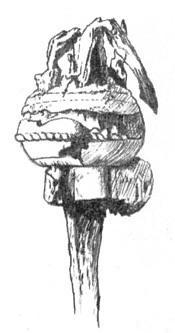Seiðstaffs of the Völur
Max Dashu
These iron staffs were all found in Norse female burials, mostly from Sweden, Norway, and Denmark, 800-1000 CE. Archaeologists originally interpreted them as "cooking spits" or measuring tools, and even now continue to be described as "handles," "baskets," or with elaborate descriptions of their structure. However, they bear a close resemblance to distaffs, on which spinners wrapped flax or wool to then draw off fiber to be spun. The resemblance of these staffs to 19th century distaffs is quite striking; compare with examples in the second row, all modern except the Norse staff from Søreim, third from left. In the third row, other seiðstaffs which although more fragmentary would have originally had much the same form.
Fulby, Denmark Myklebostad, Norway
Birka, Sweden, Grave 834
Compare the spiraling spokes of this modern distaff with the Fulby staff above it
Top of iron staff from Norse women's burial at Søreim, Norway,
circa 900
19th century distaff, origin unknown
"Birdcage" distaff, modern
Seiðstafr from Jägerbacken,
Närke, Sweden,
with broken spokesRomsdal, Norway.
The upper part has traces of the spokes, with knobs similar to the other staffs.
Norse woman's burial at Kilmainham, near Dublin, IrelandThe distaff symbolism is not present in all staffs buried with Norse women (see for example the animal-headed staff at lower right). It may or may not be part of the form of the Viking staff from Russia. A number of wooden staffs have also been found that do not take this form. Though it may be that the hollow in the top of the wood staff at Oseberg once included inserts for hanging flax or wool; it was packed in a box that contained various spinning tools, among other things like lamps.
But what needs to be considered now is a connection of the völva with the arts of the Norns, with the creative power of the spinners of fate. The distaff symbolism of the seiðstafr also seems to have been a fundamental to the strong female gendering of seiðr attested to by various Norse sagas.
Home| Articles | Secret History of the Witches | Woman Shaman dvd













